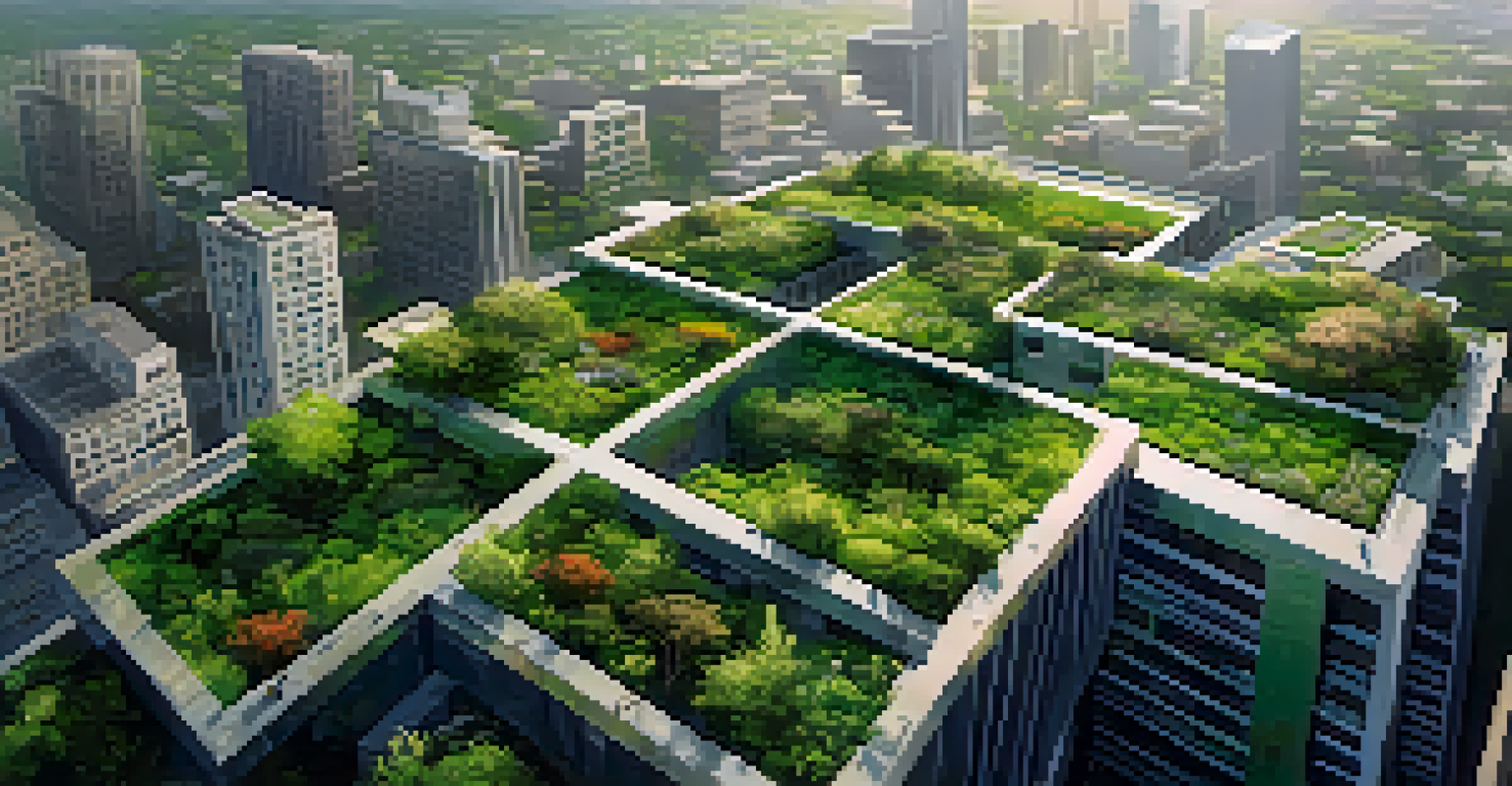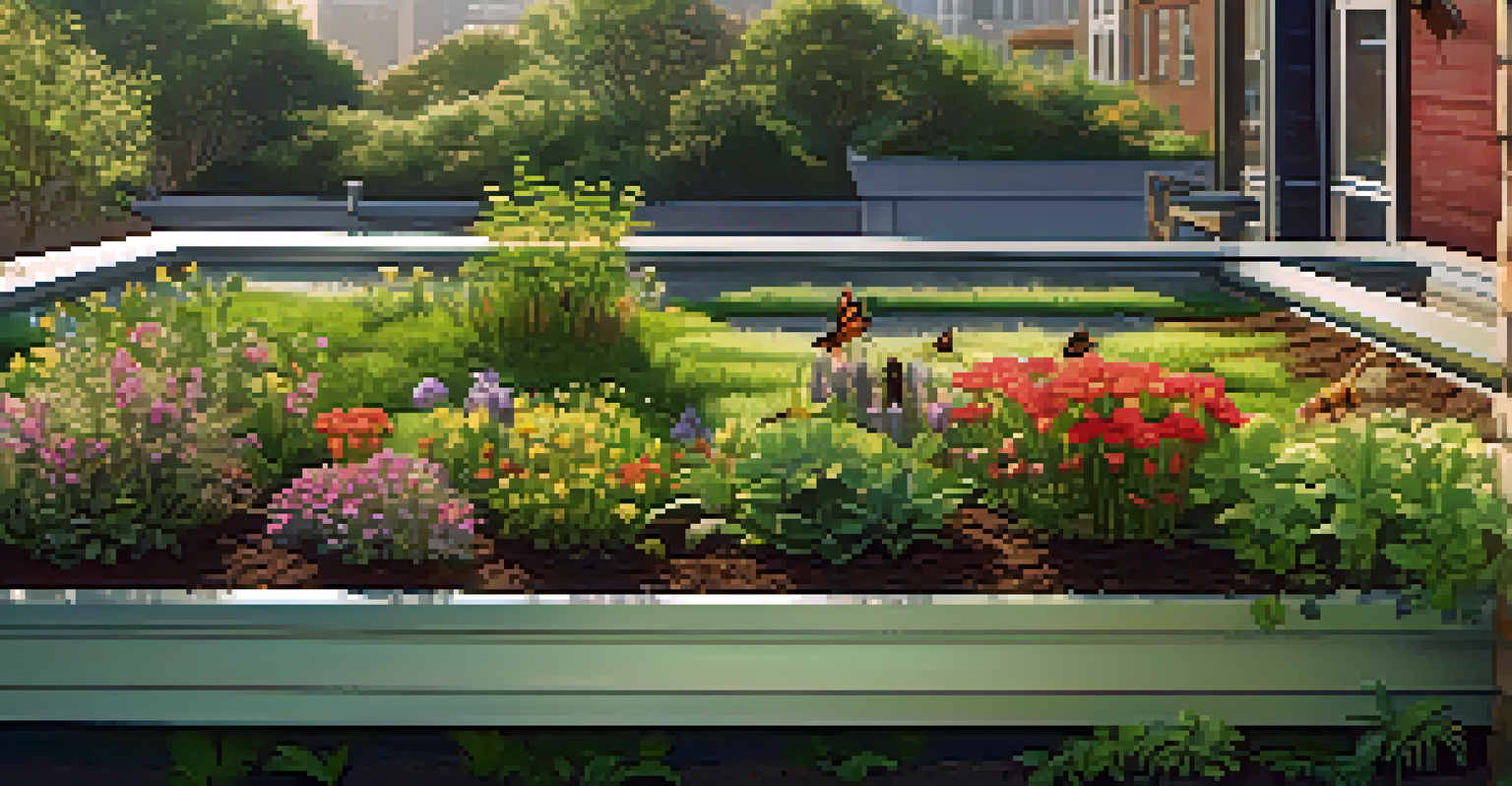How Green Roofs Contribute to Better Urban Air Quality

Understanding Urban Air Quality Challenges
Urban areas often struggle with poor air quality due to high levels of pollution. Emissions from vehicles, industrial processes, and construction activities contribute to the smog and particulate matter we often see in cities. This pollution can lead to serious health issues, including respiratory problems and heart disease.
The best way to predict the future is to create it.
In many cities, the lack of vegetation exacerbates these problems, as plants naturally filter air pollutants. As cities grow, the concrete jungle tends to replace green spaces, leading to increased temperatures and decreased air quality. Recognizing these challenges is the first step towards finding effective solutions.
One promising solution on the rise is the installation of green roofs. These innovative structures not only provide aesthetic benefits but can also play a significant role in improving urban air quality. Let's delve into how green roofs contribute to cleaner air and healthier urban environments.
How Green Roofs Filter Air Pollutants
Green roofs are essentially gardens on rooftops, filled with various plants that act as natural air filters. The plants capture airborne pollutants such as carbon dioxide, sulfur dioxide, and nitrogen dioxide through a process called phytoremediation. This means that, by simply existing, these plants help to clean the air we breathe.

Moreover, the soil and plant layers in green roofs can trap dust, pollen, and other particulate matter. This not only helps to reduce the concentration of harmful particles in the air but also creates a cleaner environment for those living and working in urban areas. It's like having a natural air purifier right above our heads!
Green Roofs Improve Air Quality
These rooftop gardens act as natural air filters, capturing pollutants and enhancing urban air quality.
In essence, green roofs serve as a buffer, reducing the amount of pollution that reaches ground level. By helping to filter these pollutants, green roofs actively contribute to improving overall urban air quality.
The Role of Vegetation in Carbon Sequestration
One of the remarkable benefits of green roofs is their ability to sequester carbon. Plants absorb carbon dioxide during photosynthesis, converting it into oxygen and organic matter. This process not only helps to reduce the greenhouse gases in the atmosphere but also contributes to cooler urban temperatures.
Nature does not hurry, yet everything is accomplished.
As cities face the dual challenge of pollution and climate change, carbon sequestration becomes increasingly vital. Green roofs can play a significant role in mitigating the urban heat island effect, where urban areas are significantly warmer than their rural surroundings due to human activities.
By integrating more green roofs into our cities, we can harness the power of plants to combat carbon emissions and contribute to a healthier planet. It’s a win-win situation for both urban dwellers and the environment.
Mitigating Urban Heat Island Effect
The urban heat island effect occurs when urban areas experience higher temperatures than their rural counterparts, mainly due to human activities and the prevalence of concrete and asphalt. Green roofs can help counteract this effect by providing shade and cooling the air through evapotranspiration.
When water evaporates from the soil and plants, it cools the surrounding air, which can make urban environments more comfortable. This natural cooling effect can significantly reduce the need for air conditioning in buildings, promoting energy conservation and lowering electricity bills.
Combatting Urban Heat Islands
Green roofs provide shade and cool the air, helping to mitigate the urban heat island effect and reduce energy consumption.
By implementing green roofs across cities, we not only improve air quality but also contribute to more sustainable urban living. The cooler cities are, the less reliant we become on energy-intensive cooling systems.
Enhancing Biodiversity in Urban Areas
Green roofs are not just beneficial for humans; they also provide habitats for various species, including birds, insects, and other wildlife. By creating green spaces in urban settings, we facilitate biodiversity, which is essential for maintaining ecological balance.
These green roofs can serve as 'stepping stones' for migratory species, allowing them to thrive in urban landscapes. This increased biodiversity contributes to more resilient ecosystems, which can better withstand environmental changes and disturbances.
Moreover, biodiversity enhances the aesthetic appeal of urban areas, making them more enjoyable for residents and visitors alike. A city that harmonizes nature with urban living is a city that fosters a sense of community and well-being.
Social and Health Benefits of Green Roofs
Beyond their environmental impact, green roofs also offer numerous social and health benefits. Access to green spaces has been linked to improved mental health, reduced stress levels, and increased physical activity. When cities incorporate more green roofs, they create more opportunities for residents to connect with nature.
Additionally, the presence of greenery can enhance property values and attract businesses, contributing to economic growth. A city that prioritizes green infrastructure sends a message about its commitment to sustainability and quality of life.
Boosting Urban Biodiversity
By creating habitats for various species, green roofs enhance biodiversity and ecological balance in cities.
Ultimately, green roofs not only beautify urban landscapes but also enrich the lives of those who inhabit them. Healthier residents lead to healthier communities, creating a positive feedback loop that benefits everyone.
The Future of Green Roofs in Urban Planning
As cities continue to grow and face increasing environmental challenges, the integration of green roofs into urban planning becomes essential. Planners and architects are starting to recognize the multifaceted benefits of these installations, promoting them as vital components of sustainable development.
In many regions, policies and incentives are emerging to encourage the adoption of green roofs. These initiatives can include grants, tax breaks, or zoning regulations that favor green building practices. Such support is crucial for making green roofs a standard feature in urban design.

Looking ahead, the future of green roofs is bright. With continued advocacy and innovation, we can transform our cities into greener, cleaner, and more livable spaces for generations to come.